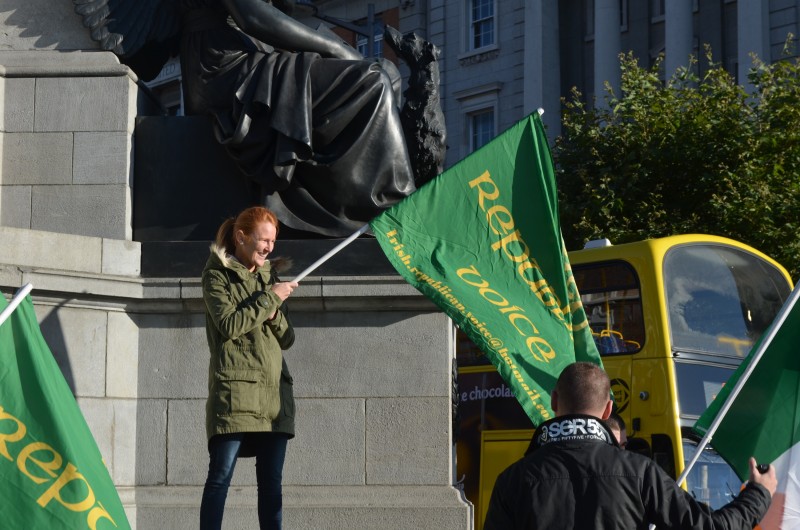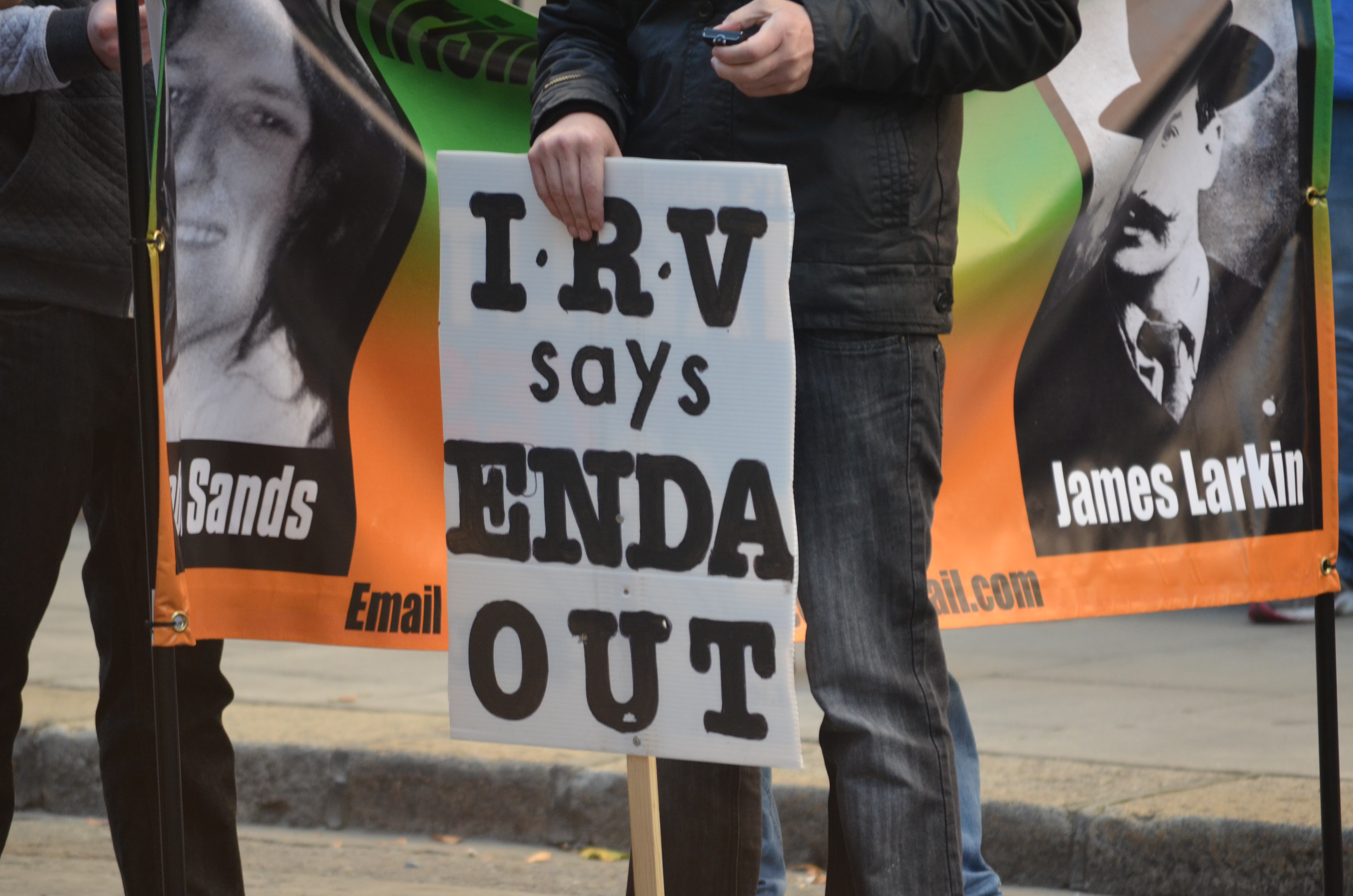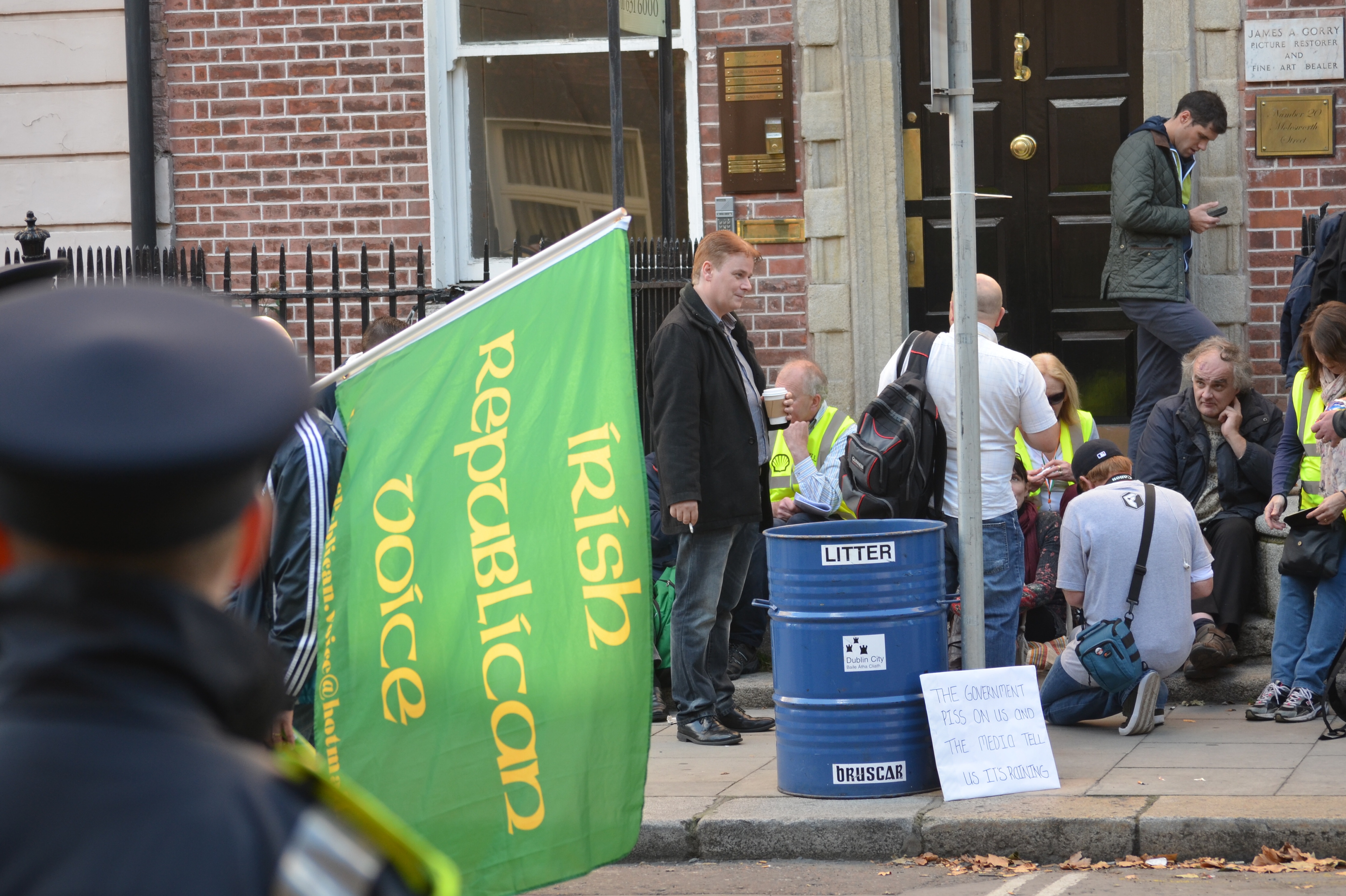Jane Fallon | Contributing Writer
When Dáil Éireann reconvened following the Summer recess on Wednesday the 19th of September, the reception it received was anything but welcoming. Around 500 protesters jostled with Gardaí outside the Kildare street gates, demonstrating their dissatisfaction with government policy, namely in relation to austerity measures. As the day progressed violence broke out among demonstrators and the Gardaí with the latter resorting to the use of batons and pepper spray as a means of crowd control. The ripples of dissatisfaction were also felt by some 3,000 commuters as they attempted to navigate their way home through traffic diversions caused by a sit in on O’ Connell Bridge.
Clearly distinguishable among the throng of the anti-austerity protesters were emerald green flags with gold lettering advertising “The Irish Republican Voice”. If this name seems familiar to many of you, it is not surprising. The group’s posters have decorated Dublin lampposts over the past few months. White A4 sheets with the slogan “Join Irish Republican Voice” flanked by images of Jim Larkin and Bobby Sands and accompanied by a mobile phone number have become a regular sight on many students’ commute to college. It was not the mass circulation of these posters out that captured my interest, but rather the informality of the tone and the information displayed. Therefore, when the flags of the Irish Republican Voice surfaced outside the Dáil that day I found myself wondering if the group amounted to more than their advertising techniques suggested.
A few weeks later, the group’s name featured in lunchtime conversation once more, this time for staging a protest outside The Little Museum of Dublin on St. Stephen’s Green. The group had been spotted standing outside the building protesting for reasons that weren’t quite clear. Having failed to find a website for the group, I eventually stumbled upon their Facebook page under the title of “IrishRepubli Can Voice Dublin.” The page explained that the protest was “demanded” as “The minister for slashing social welfare payments, Joan Burton & the austerity-loving general secretary of SIPTU, Jack O’ Connor” were speaking about the 1913 lockout. This highlighted what appeared to be the general confusion in relation to the group. Did they want to continue the work of people like Bobby Sands and achieve a united Ireland, or to demonstrate against the current government?
Although I remained skeptical having read the somewhat unprofessional posters, when I dialled the mobile number, a representative of the movement did indeed pick up and answer my questions. He explained that the group was founded four months ago by a group of people largely composed of past members of Sinn Féin and the dissident splinter group of Sinn Féin, the 32 County Sovereignty Movement. Once a committee in Sinn Féin, 32CSM removed themselves from the association claiming that the issue of sovereignty was no longer being adequately addressed by the party. The spokesman for IRV explained that many of the group’s current followers had become disenchanted with the aims of Sinn Féin and 32CSM for what they perceived to be its failure to tackle the current problem facing the Irish people: austerity. The Irish constitution was not being upheld, he explained, as it called for all Irish people to be equal and such was not the case under the current government. Furthermore he explained that the group felt that democracy no longer exists in Ireland, especially following the reaction of guards towards protesters at the Dail opening demonstration. The IRV member that I spoke to described the Guard’s treatment as being “heavy-handed” and uncalled for, suggesting that they reacted out of fear that all groups present would unite against the government. He was adamant that his group did not initiate the violence nor were they a terrorist group as suggested in certain media reports, but rather were left with no alternative but violent retaliation when faced with the methods of the Gardaí.
no alternative but violent retaliation
The sense of the group being somewhat disorganized returned after I asked them about their structure. Although they have participated in demonstrations, distributed flyers, and are actively seeking members, the group have yet to elect a leadership. The spokesman assured me that once their numbers increased an Ard Fheis would be held and a president and vice president elected by members from branches all over the island. While he informed me that membership was still quite low, he would not disclose how many active members the group currently has. However, he did say that they would have a branch in each of the 32 counties, although he admitted that so far branches have only been established in Carlow, Belfast and Dublin. The group’s aims span a wide spectrum, from reclaiming the six Northern counties to targeting bullying. The images on their Facebook page mirror this with slogans ranging from “Reclaim the Irish nation destroy British occupation” to “I.R.V says bullying is for losers”. They appear to see themselves as a group to alleviate any grievances that the Irish people may have.
“Reclaim the Irish nation destroy British occupation”
IRV assured me that they would join any protest into which they were invited but would hijack none. Although they appeared to applaud peaceful protest in the south, when I brought up the Good Friday Agreement their idea of what constituted an appropriate response varied. In the case of the north the representative explained, the six counties are being “occupied” and that in taking back what is rightfully Ireland’s they will support an “armed struggle”. Although I mentioned the results of the border poll which showed that the majority of those living in the six counties wished to remain under the control of the U.K, the I.R.V rejected this saying that those who conducted the poll controlled the results and therefore it could not represent the people’s wish. Furthermore they stressed that even recognising the border poll or the Good Friday Agreement was to recognise Britain as having authority in the north, something they were not willing to do. Finally, before I hung up, they reminded me that the name Irish Republican voice came from the idea of giving people a voice and that is why they appear at demonstrations, to support the Irish people. In relation to those of us Irish who have been branded ‘generation emigration’ he urged us to “stay and fight” promising that “times will get better” emphasising that leaving allows the government to win and cements the “just get on with it” attitude of the populace. Before the call ended he stressed that all was required to bring an end to this government was for the masses to take to the streets for 24 hours and so as I hung up I was already excited to see how their budget day protest would unfold.
The protest was due to begin on O Connell street at 9:00am and the group had issued statements calling on “all the people of Ireland to come to Dublin” declaring that they would “defend the state with the sound of defiance”. I arrived at the G.P.O at five to nine ready to witness “the revolution that’s now underway.” Instead I encountered swarms of gardaí. There was a van of riot police and several unmarked cars carrying even more members of an Garda Síochana donning their neon yellow jackets. The gardaí and I had prepared ourselves for something big, something big which did not seem to be forthcoming. I passed the morning walking up and down O’ Connell Street. Given that the street is only five hundred metres long I was certain that there was no chance of escaping the wrath of IRV’s protest. After an hour and twenty minutes a guard told me there was a group under the statue of O’ Connell.
I soon saw the emerald and gold flags, although they were not accompanied by the vast crowd I was expecting. To be honest the guard was being generous in referring to them as a group of protesters! Three men and a woman stood under a sign that said “We are peaceful protesters not criminals” carrying three I.R.V flags and a tri colour, while a fifth man stood on front of them and informed me when I asked that this was the protest. Noticing that I seemed doubtful, he added that he hoped more would show up later. One of the flag bearers echoed this, assuring me that it would all go down outside the Dáil. In anticipation of the announcement of the budget at half-past two, I arrived at Kildare Street at a quarter-past. There was no sign of IRV.
the guard was being generous in referring to them as a group of protesters
I headed back to O’ Connell street looking for them and while I found yet more gardaí and vans of riot police, still there was no sign of the group. I decided to return to Kildare street to see the protest and there I discovered a small band of no more than fifteen people under a large green IRV banner. Other groups were also present including Sinn Féin and various anti-austerity groups. However, the overall turnout was decidedly poor. With the images on the news of the last protest to the forefront of my mind I prepared myself to see the IRV in action. Two hours after the budget was announced there was still little happening among the demonstrators. Most stood around talking. Some people appeared to be having a picnic. One man began to address the crowd. The I.R.V began to wrap up their posters and lay them aside as the man continued speaking. During his speech he personally distanced himself from IRV, saying he had nothing to do with them and later jeering them for putting away their posters prematurely. The solidarity of the revolution appeared to be disintegrating before my eyes.
The notion of the rising profile of Irish Republican Voice is legitimate in terms of its reoccurrence as a topic of casual conversation, although it appears somewhat fictional in its physical presence as an effective pressure group. Furthermore, in the aftermath of what has been largely deemed a more tolerable budget than those of recent years, it is also questionable whether there is a demand for this brand of all-encompassing republicanism. Nevertheless, it is unwise to disregard any ideologically determined pressure group, or to fail to consider outside the boundaries of narrow media caricatures. While the I.R.V may have retired its banners in relation to Budget 2014 it is most likely that its green and gold flags will rise again in Dublin in the near future.









